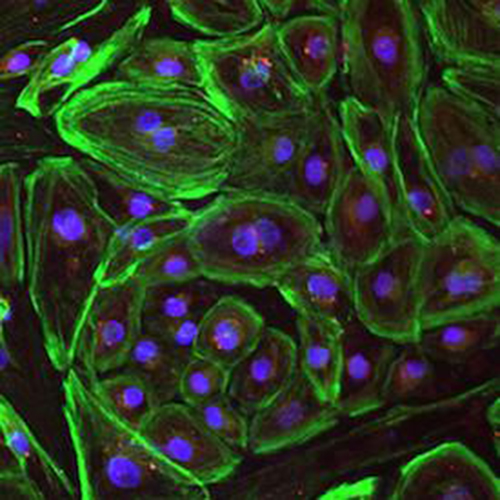
Image shows heart muscle that is missing the dystrophin molecule. (Credit: UT Southwestern)
Using the new gene-editing enzyme CRISPR-Cpf1, researchers at UT Southwestern Medical Center have successfully corrected Duchenne muscular dystrophy in human cells and mice in the lab.
The UT Southwestern group had previously used CRISPR-Cas9, the original gene-editing system, to correct the Duchenne defect in a mouse model of the disease and in human cells. In the current work, they used a new variation of the gene-editing system to repair the defect in both a mouse model and in human cells.
“We took patient-derived cells that had the most common mutation responsible for Duchenne muscular dystrophy and we corrected them in vitro to restore production of the missing dystrophin protein in the cells. This work provides us with a promising new tool in the CRISPR toolbox,” says author Dr. Eric Olson, Chairman of Molecular Biology, Co-Director of the UT Southwestern Wellstone Muscular Dystrophy Cooperative Research Center, and Director of the Hamon Center for Regenerative Science and Medicine.
The research appears in the journal Science Advances.
CRISPR-Cpf1 differs from CRISPR-Cas9 in a number of key ways. Cpf1 is much smaller than the Cas9 enzyme, which makes it easier to package inside a virus and therefore easier to deliver to muscle cells.
It also recognizes a different sequence of DNA than Cas9 does, which provides greater flexibility in terms of use. “There will be some genes that may be difficult to edit with Cas9 but may be easier to modify with Cpf1, or vice versa. The two proteins have different biochemical properties and recognize different DNA sequences, so these properties create more options for gene-editing,” says Dr. Olson, who holds the Pogue Distinguished Chair in Research on Cardiac Birth Defects, the Robert A. Welch Distinguished Chair in Science, and the Annie and Willie Nelson Professorship in Stem Cell Research.
“By either skipping a mutation region or precisely repairing a mutation in the gene, CRISPR-Cpf1-mediated genome editing not only corrects Duchenne muscular dystrophy mutations but also improves muscle contractility and strength,” says co-author Dr. Rhonda Bassel-Duby, Professor of Molecular Biology and Associate Director of the Hamon Center for Regenerative Science and Medicine.
Duchenne muscular dystrophy is caused by a mutation to one of the longest genes in the body. When there is a DNA error in the dystrophin gene, the body doesn’t make the protein dystrophin, which serves as a sort of shock absorber for the muscle fiber. Since there are numerous places in the dystrophin gene where a mutation can occur, flexibility for gene-editing treatment is crucial.
Duchenne occurs in about 1 in every 5,000 boys, according to the Centers for Disease Control and Prevention. Duchenne muscular dystrophy is a progressive disease affecting both muscle used for movement and heart muscle, with patients typically succumbing before age 30 due to heart failure.
“CRISPR-Cpf1 gene-editing can be applied to a vast number of mutations in the dystrophingene. Our goal is to permanently correct the underlying genetic causes of this terrible disease, and this research brings us closer to realizing that end,” Dr. Olson says.
“CRISPR-Cpf1 differs from CRISPR-Cas9 in a number of key ways, including being easier to deliver to muscle cells, says Yu Zhang, a graduate student in Dr. Olson’s lab and the first author of this study.


